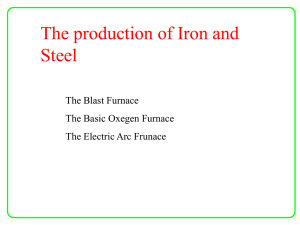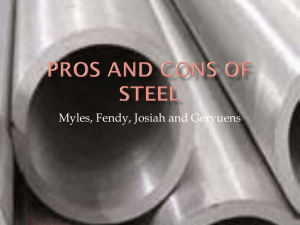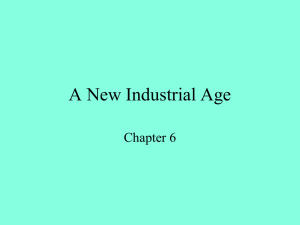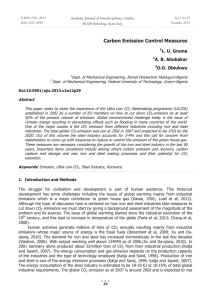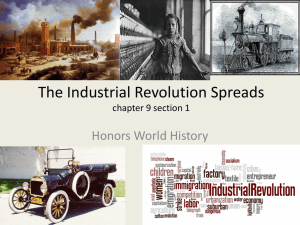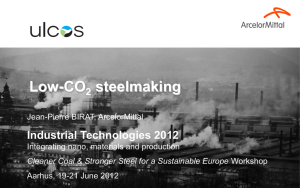Hisarna, a revolution in steel making
advertisement
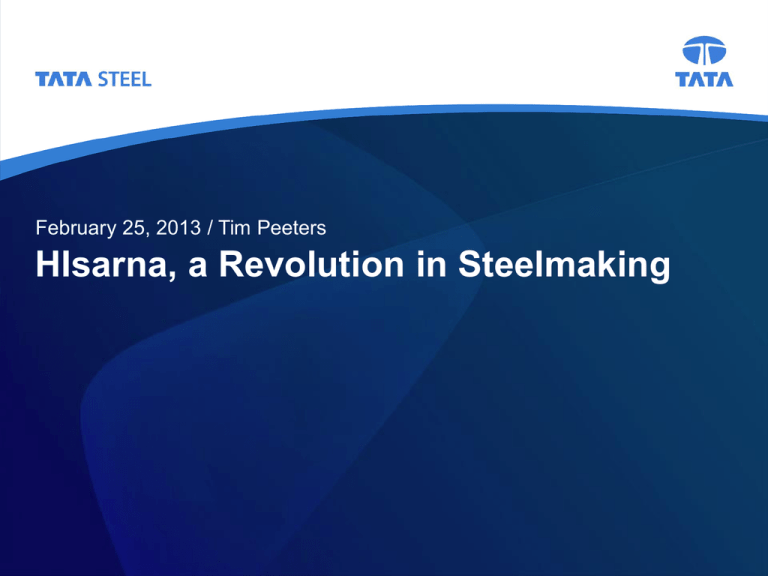
February 25, 2013 / Tim Peeters HIsarna, a Revolution in Steelmaking Paper & Steel : Common Ground? • CO2 intensive (1.1% vs 4% of man made CO2) • Energy intensive • High recycling rate (70% vs 95%) • Capital intensive • Major facilities > 20 years life span • Large sites, large installations • Threshold for implementation of breakthrough technologies • Trend of past 20 years • Process efficiency, labour productivity increase • From Fragmented to Consolidated industry • Changing competitive landscape in major markets • Sustainability and Climate Change challenge 2 The Challenge in Steelmaking Growth World steel consumption will double in 2050 Sustainability Ambition to cut CO2 emissions by 50 % in 2050 3 The International Approach • Climate Change is Global • Climate Change is Long Term • Support at board level, governmental level, EU level • Build industrial partnerships, bring people together • Use a broad range of expertise • Build a common language The Brand: Ultra Low CO2 Steelmaking 4 The ULCOS project Objective: 50% reduction in CO2 emissions per ton of steel from iron ore based steel production by 2050 • Globally the largest steel industry project on Climate Change mitigation • Core partners: ArcelorMittal, Tata Steel, ThyssenKrupp, Ilva, Voestalpine, LKAB, DillingerHütte/Saarstahl, SSAB, Rautaruukki • Co-partners: 48 Institutes, Universities, Engineering companies, etc • Budget: 75 M€ • Duration ULCOS I: 2004 – 2010 ULCOS II: 2011 – 201… 5 ULCOS Consortium: 48 partners 6 Idea Experiment Pilot Demo Industry 2004 ULCOS - I Project CO2 and sustainability modelling Inventory of 200 process options 2010 ULCOS - II Project 201.. progress Selection Pilot plant Industrial Demo Selection Criteria • CO2 • Economical • Technical maturity • Social acceptance • Other environmental aspects • Fit with existing configurations 7 Common approach, definitions, boundaries Sintering Plant Coke Oven Gate to Gate approach for the Classical Integrated Steel Mill Power Plant Blast Furnace Basic Oxygen Furnace Everything is assessed for one ton of Hot Rolled Coiled (HRC) Focus area: Ironmaking is responsible for 85-90% of CO2 per HRC Hot Rolling 8 Selection Process: Funnelling the Options 2004 ULCOS - I Project 2010 ULCOS - II Project 201.. 4 processes selected CO2 and sustainability modelling Inventory of 200 process options Selection Top Gas Recycling Blast Furnace Better use of Carbon in retro-fitted plants HIsarna Better use of Carbon in a new process Gas based reduction Replacing Carbon with Natural Gas or Hydrogen Electrolysis of iron ore Green power, mimic Aluminium production 9 Top Three Hurdles to Manage • Technical • High intensity, high efficiency process development • Focus on generic long-term solutions • Financial • High risk, high reward • Partnering: sharing benefit + cost + effort + risk • Industry contribution + local / national / European funding • Organisational • • • • • Consortium People: availability, expertise, critical mass Communication Public relations Intellectual property 10 Steel Production Process Route Where does HIsarna fit? Iron ore coal Ironmaking Steelmaking Casting Steel products Rolling & Coating 11 HIsarna technology Comparison with the Blast Furnace route Blast furnace sinter Iron ore coke Liquid iron coal 12 HIsarna technology Comparison with the Blast Furnace route Blast furnace sinter Iron ore coke coal Direct use of coal and ore No coking and agglomeration Liquid iron 13 HIsarna pilot plant 2012 2010 2011 2009 2007 7 years of preparation before the first experiments 2004 14 Key Success Factors • Commitment from all levels Construction • Financial support September 2010 • Logistical, Engineering and R&D know-how on site • Cooperation • Perseverance • Fast cycle of learning and improving 15 Cold Commissioning, January 2011 16 First Start-up, April 2011 17 First HIsarna Hot Metal, May 2011 Production runner HIsarna pilot plant 18 HIsarna Summary • With the ULCOS and HIsarna project the European steel industry is proactively approaching the Climate Change issue • In the HIsarna project knowledge and experience of steelmakers and equipment suppliers from all over Europe is brought together • HIsarna is a high risk/high reward innovation with the potential to have a strong environmental and economical impact on the steel industry • Environmental impact: • Without CO2 capture and storage 20% reduction • With CO2 capture and storage 80% reduction • Strong reduction of other emissions • Economical impact: • Wider range of raw materials • Lower CapEx, OpEx 19 Challenges for HIsarna Future • Demonstrate robustness of technology • Further pilot plant campaigns: people, time, funding • Up-scaling to industrial size • Transition from “generic” to “specific” (location, size, configuration) • Investment 250 M€ (± 50 M€) • Demonstration scale should have a competitive business case • Governments can support this • Many potential innovations in ironmaking have not survived this step • Sustainable industry future, supported by National and European policies • Review the 2050 Roadmap (environmental, economical, social landscape) • Develop business case for pushing out Blast Furnace technology 20 What have we learned along the way? • Think big: Focus on breakthrough, not incremental • Partnerships, collaboration, trust • Set scope, targets, common definitions • Clear funnelling & selection process: • Generic, Long Term solutions • Handle good ideas outside the scope • Don’t bet on one horse • When stakes get higher, stay connected with the business strategy • Innovation comes from people with expertise 21

